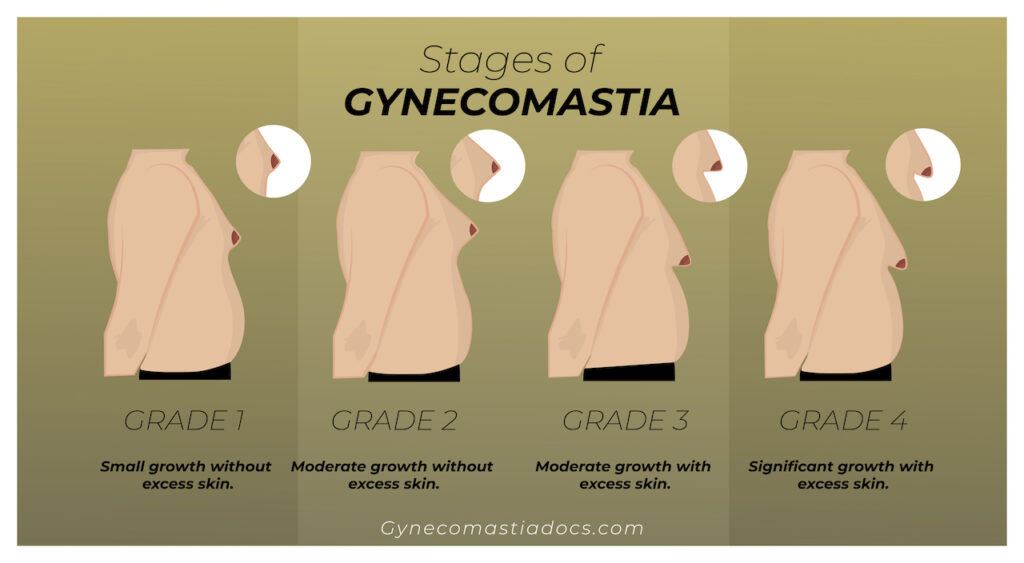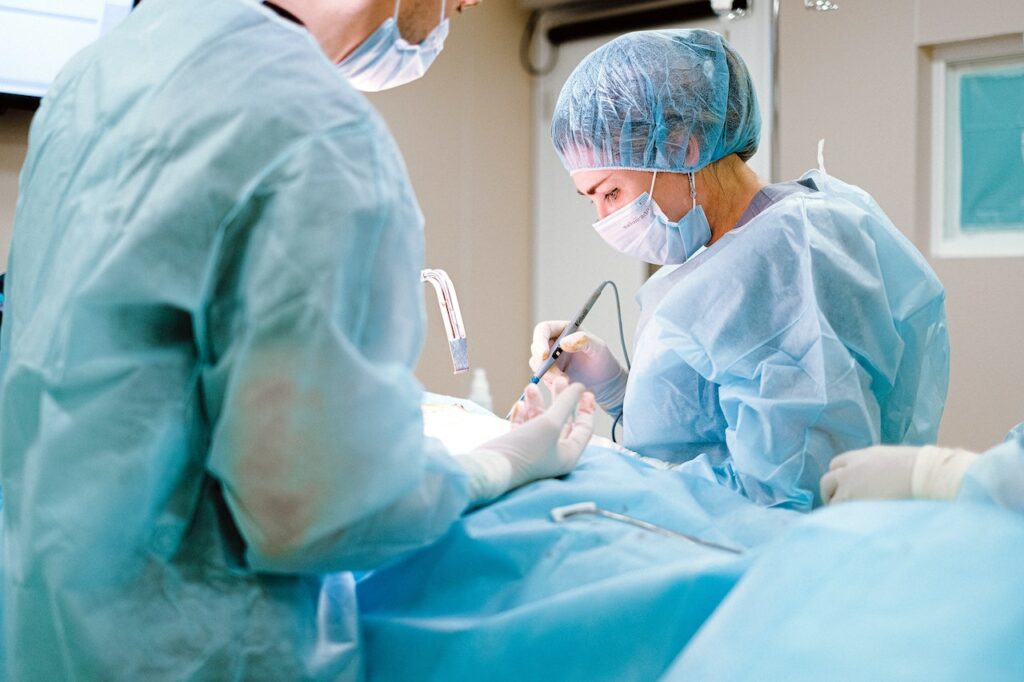Gynecomastia grades or stages are helpful to determine the severity of a patient’s gynecomastia condition. There are, in total, four grades of gynecomastia.
They range in severity from grade 1 (mild) to grade 4 (severe), and each stage has a number of characteristics that distinguishes it from the other grades.
The treatments for each grade also differ, with stage 4 treatment requiring a very different surgical approach in comparison to stage 1.
Read on to learn more about these gynecomastia grades and to better understand where you may fall on the spectrum.
What Are the Stages of Gynecomastia?
The four stages of gynecomastia are:
- Grade 1: small growth without excess skin
- Grade 2: moderate growth without excess skin
- Grade 3: moderate growth with excess skin
- Grade 4: significant growth with excess skin
There are a number of other signs and symptoms associated with each stage, which we’ll get to later.
It is important to note from a medical standpoint, gynecomastia is defined as overdeveloped breast gland tissue. However, it is quite common for there also to be excess fat tissue in the breast.
Both excess breast gland tissue and excess fat tissue can be removed during an overall gynecomastia procedure.

Overview of the 4 Grades of Gynecomastia
Let’s take a look in more detail at each stage of gynecomastia and what they entail.
Grade 1 Gynecomastia: Small Growth without Excess Skin
Sufferers of grade 1 gynecomastia suffer from a small amount of breast growth, sometimes accompanied by pain or tenderness in the nipples. The swelling around the nipple is only slight, and the area may sometimes be discolored. The nipple is sometimes puffy and tender to the touch.
Stage 1 gynecomastia is generally not seen when the patient is clothed. However, it may be noticeable if the patient is in a state of undress (such as at the beach or a swimming pool), and may cause embarrassment in these instances.
Grade 2 Gynecomastia: Moderate Growth without Excess Skin
Grade 2 gynecomastia is a moderate growth in breast tissue across the width of the chest.
It may be noticeable even when the patient is clothed and is quite noticeable if the patient is bare-chested. This can cause significant embarrassment if the patient is around other people.
The nipple may also be puffy and tender to the touch in many cases.
Can You Get Grade 2 Gynecomastia?
Gynecomastia occurs in the four stages specified, so it’s not possible to suddenly develop stage 2 gynecomastia (or even later stages). Each stage of the condition is experienced.
However, stage 1 gynecomastia is so mild that it’s possible that it goes unnoticed by the patient and undiagnosed by medical professionals.
It’s therefore often the case that the condition isn’t caught until it’s in stage 2. This gives rise to the misconception that it’s possible to spontaneously develop stage 2 gyno.
Grade 3 Gynecomastia: Moderate Growth with Excess Skin
At stage 3 of gynecomastia there is considerable development of breast tissue in the chest to the point where the chest is wider. Breast protrusion is prominent, and is likely noticeable even through clothing.
The breasts are quite enlarged, and nipples may be large and puffy. Breast tissue may have developed to a point where the breasts are ‘droopy’ with skin excess.
As the breasts are now visible even through clothing, the gynecomastia may be a source of significant distress and anxiety in the patient.
Grade 4 Gynecomastia: Significant Growth with Excess Skin
The most extreme stage of gynecomastia is grade 4. At this stage, breasts are prominent and full to the point of often resembling female breasts.
Breast tissue is developed to the point where the breasts are easily perceived through clothing. A large amount of extra skin is present, and nipples are large and puffy.
Gynecomastia Grades: What are the Treatments?
The various stages of gynecomastia differ in severity, and so it’s not always the case that more drastic treatments (such as surgery) are required. Let’s take a look at the different treatment options for various grades of gynecomastia.
Treatments for Gynecomastia Grade 1
Because stage 1 gynecomastia is still in the early stages of the condition, it’s often possible to treat it without recourse to surgical measures.
Off-Label Medications
Certain medications can be used for the treatment of gynecomastia, despite that not being their original purpose.
These include raloxifene (usually used to treat osteoporosis) and tamoxifen (used to treat and prevent breast cancer in both sexes). Always be sure to speak with expert doctors before taking any medications.
Adolescent/Infant Gynecomastia
Both adolescent and infant gynecomastia are usually just short term conditions caused by a temporary imbalance in hormones.
Adolescent gynecomastia usually resolves itself within a year or two, and infant gynecomastia in a matter of months.
Resolution of Underlying Conditions/Habits
Gynecomastia can quite often be caused by an underlying condition or a substance abuse problem (e.g. marijuana, alcohol or anabolic steroids).
In either case, resolution of the condition or habit while gynecomastia is still in stage 1 may result in the condition going away by itself.
Does Gynecomastia Grade 1 Go Away?
It is possible for grade 1 gynecomastia to be resolved before the condition progresses by using one (or more) of the above methods.
Unfortunately, gynecomastia may still persist or even get worse. In these instances, different surgical options may be pursued.

Treatments for Gynecomastia Grade 2
Surgical treatments can (and should) be considered for stage 2 gynecomastia. At this stage, the breast gland tissue is developed to the point where it’s unlikely to reverse the condition with treatments that may have been viable at stage 1.
Excision of Breast Gland Tissue and/or Liposuction
To treat gynecomastia caused by excess breast gland tissue, surgery is performed to remove the excess gland for best results.
In cases, where there is also excess fat tissue, liposuction is usually performed as well. The liposuction surgical procedure involves making small incisions into the breast and then sucking out the excess fat tissue.
Coolsculpting
Coolsculpting is an entirely non-invasive procedure to reduce fat. Fat cells are targeted and frozen with the use of a special wand placed on the skin. Then the fat is broken down into liquid & reabsorbed into the body.
Although Coolsculpting may reduce the fatty tissue, it does not remove the breast gland tissue, and as such may not be a long-term solution to the problem.
It should also be noted that Coolsculpting is generally not nearly as effective as liposuction to reduce excess fat.

Treatments for Gynecomastia Grade 3
Similarly to stage 2, grade 3 gynecomastia has reached a stage where surgery is the only real option.
Excision of Breast Gland Tissue and/or Liposuction
This procedure combines the removal of the breast tissue/glands with liposuction in order for the most effective possible results.
This will not only eliminate all signs of gynecomastia, but will quite often ensure the best look post-surgery.
In addition to removing the excess breast gland and/or fat tissue, excess skin is also removed with grade 3 gynecomastia. In these cases, the breast skin is tightened by usually hiding the scar at the edge of the areola.
Treatments for Gynecomastia Grade 4
Similar to grade 3, surgery is the only option at this point. Most likely, grade 4 will include both excess fat & breast tissue, and excess skin. This means that all excess portions will be removed to ensure successful surgical results.
See the above grade 3 treatments for the various procedure options.
With stage 4 gynecomastia, it should be noted that it is a more extensive surgery resulting with more scars on the breast.
After consulting with your surgeon, you will have a better sense of what the best procedure will be for your case of gynecomastia.

Is There a Difference in Treatments for Gynecomastia vs. Pseudogynecomastia?
Simply put: yes. Although there is some overlap in treatments, the two conditions have different causes.
This means that they are treated in different ways, with much more of an emphasis on addressing hormonal imbalances in case of true gynecomastia.
Pseudogynecomastia, on the other hand, is caused by excess fat tissue, and may potentially be handled by lifestyle changes (diet and exercise, primarily).
So, if your man boobs are purely due to excess fat, you may be able to avoid surgery with the necessary lifestyle changes (although liposuction is still common to remove any additional fat).
However, If your man boobs are also caused by excess breast gland tissue, then surgery to remove the gland tissue will essentially be your only option.
Gynecomastia Grades Recap
Gynecomastia is a complex condition with significant differences between the various grades, and each grade must be assessed independent of the others.
That said, there are treatments that can be used across most of the stages, and it’s entirely possible (but not strictly necessary) to consider surgical options even in stage 1.
It’s important to consider all of your options very carefully and consult with your doctor before making any final decisions, whether your gynecomastia is grade 1 or 4.
Surgical options may not be necessary or desirable in your case. Conversely, it might be a good idea to bite the bullet and have surgery sooner rather than later.
Whatever your decision (and the advice of your doctor), the one thing that you should not do is simply ignore a case of gynecomastia. Unless you’re an adolescent (or an infant), it’s usually not going to go away by itself.
See a doctor and start exploring your options today.
